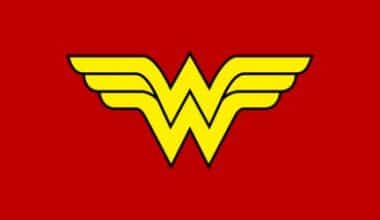NVIDIA’s first logo featured a black and green color scheme. The company chose the “all-seeing eye” graphic to represent NVIDIA’s vision and the never-ending quest for innovation. However, half of the all-seeing eye in NVIDIA’s visual identity is white and black, while the other half is white with a green square above it. NVIDIA changed its logo slightly in 2006, with green replacing black in one half and white in the other. The square remained green, but in a darker hue.
After 2006, there were a couple of other changes to the NVIDIA logo; all of which we will cover in this article.
The Evolution of the NVIDIA Logo
The visual identity of NVIDIA is based on a theoretical graphical symbol that represents the famous symbolic “all-seeing eye.” While the font and color scheme of the inscription has changed over time, the overall concept has remained consistent.
1993-2006
The first NVIDIA logo appeared in 1993. This was when the all-seeing eye became its primary visual symbol. This logo design has a long history and is commonly associated with the “eye of the Almighty,” which sees everything. However, in this context, the eye has a different symbolic meaning. INVIDIA’s “all-seeing eye” is constantly looking for innovation and the future.
The original NVIDIA symbols were divided into two halves: black and white. A green square was placed on top of the white half. The wordmark featured an “n” written in a distinctive italic font.
2006–Today
In 2006, NVIDIA redesigned its logo and wordmark. The “all-seeing” eye was no longer black, and the font changed shape and became bolder. The italicized “n” has been replaced with a capital letter.
Elements of the NVIDIA Logo Design
- Symbol: The name NVIDIA is derived from the Latin word “Videre,” which means “to see or perceive.” The company’s logo features a stylized “elliptical eye,” resembling the letter “e.” The symbol is thought to be a nod to Horus, the solar god of Ancient Egypt,” who reigned with two eyes.”
- Color: The NVIDIA symbol’s green represents originality, uniqueness, and growth, while the white represents elegance, perfection, and charm.
- Font: The customized uppercase font for the wordmark is clear and legible. It was created specifically for the company. The first version of the wordmark used a serif font, while the second used a sans serif font.
NVIDIA Symbol
The first NVIDIA symbol was composed of two parts: black and green. The “eye” was black on one half and white on the other, with a green square over it. The wordmark with a distinct italicized “n” is shown below.
NVIDIA Emblem
Both the symbol and the wordmark were redesigned in 2006. The “eye” lost its black color, while the typeface became bolder and changed shape. The italicized lowercase letter “n” was replaced with a capitalized one.
Colors and Font
There are various interpretations of the spiral pattern. Some believe that this all-seeing eye is a well-known Masonic symbol. Others think this is an eye always looking for something new. Others base their theory on Roman mythology because Nvidia’s name is derived from the word “Invidia” – the Romans called the goddess Nemesis this way. She was envious, angry, and jealous, and ancient people believed envy came from the eyes.
What is the source of this mythological subtext? Nvidia’s primary goal is to develop technology products that are the envy of all competitors. There is also speculation that the eye of the emblem is linked to the ancient Egyptian deity Horus and its symbol, the udjat falcon’s eye.
The fonts on the old and new Nvidia logos are indistinguishable. What is clear is that two types of typefaces were used in the first case: straight uppercase serifs and lowercase italics. Although the first “N” still appears in lowercase, all characters are now uppercase. The text is highlighted in Eerie Black (# 1A1918), with rich lines that lack serifs at the ends. If not for the unique design of the capital “N,” one might assume this is a standard grotesque.
In contrast to the lettering, the square and half of the spiral eyes are green. The designers chose Apple’s shade (# 7AB547) for a darker shade than the previous version. This color is also associated with envy; additionally, the goddess Invidia, according to ancient Roman beliefs, was green. Nvidia even coined “Green with Envy” to describe the GeForce 8 series of graphics accelerators. So the palette’s symbolic significance is undeniable.
The Origins of NVIDIA
NVIDIA was founded in April 1993 by its current CEO, Jensen Huang, a Taiwanese-American, Chris Malachowsky, and Curtis Priem.
Huang previously worked at AMD (Advanced Micro Devices) as a microprocessor designer and the CoreWare director at LSI Logic, while Malachowsky was an electrical engineer at Sun Microsystems. Priem previously worked as a graphics chip designer and senior staff engineer at Sun Microsystems.
The three co-founders believed that graphics-based or accelerated computing was the way to go for the next generation because it could solve problems that general-purpose computing could not. They also believed that video gaming would be one of the most challenging computational difficulties and have an extremely high sales volume.
NVIDIA used video gaming as a flywheel to enter large markets and fund large-scale research and development to solve massive computational challenges. NVIDIA was founded with only $40,000 in funding. Following that, NVIDIA received $20 million in venture capital funding from several investors, including Sequoia Capital.
NVIDIA was initially unnamed, and the three co-founders named all of their files NV, which stands for “Next Version.” Because the company needed to be registered, the co-founders were required to review every word that contained the letters N and V. This gave rise to the name “INVIDIA,” which means “envy” in Latin. NVIDIA first went public in January 1999.
NVIDIA’s New Products and Acquisitions
NVIDIA released RIVA TNT in 1998, solidifying its reputation for producing high-quality graphics adapters. The GeForce 256 was released in late 1999, and it was notable for introducing onboard lighting and transformation in customer 3D hardware.
This feature, which had four-pixel pipelines and ran at 120 MHz, performed advanced video acceleration, hardware sub-image alpha blending, and motion compensation. The GeForce vastly outperformed existing products.
Because of the popularity of NVIDIA’s products, the company won the contract to develop Microsoft Xbox graphics hardware, earning $200 million in advance. Unfortunately, the project diverted many of the company’s top engineers away from their work. This didn’t matter in the short term, as the GeForce2 GTS was released in the summer of 2000.
In December of the same year, NVIDIA agreed to purchase the intellectual property of 3 DFX, a former competitor and pioneer in customer 3D graphics technology since the mid-1990s. The purchase was completed in April 2002.
In July 2002, NVIDIA purchased Exluna for an undisclosed sum. Exluna created software-delivery tools, and its employees were absorbed into the Cg project. NVIDIA purchased MediaQ for around $70 million a year later.
Read Also: HOW TO CALCULATE TIME AND A HALF
NVIDIA acquired iReady, a high-performance iSCSI, and TCP/IP solutions provider, in April 2004. In December of that year, NVIDIA acquired ULI Electronics, which supplied third-party Southbridge chipset components to ATI.
NVIDIA acquired Hybrid Graphics in March 2006. In December of that year, NVIDIA and its main competitor in the graphics market, AMD (which had acquired ATI), received a court summons from the Department of Justice regarding possible antitrust violations in the video graphics industry.
NVIDIA acquired PortalPlayer, Inc. in January 2007, followed a year later by the acquisition of Ageia. Ageia created the PhysX physics processing unit and engine. The company announced that all future GPU products would include the PhysX technology.
NVIDIA introduced its Tegra III ARM system for mobile devices in November 2011. According to the company, the chip contains the world’s first quad-core mobile CPU. In May 2011, NVIDIA agreed to pay $367 million for Icera, a UK-based baseband chip manufacturer.
In January 2013, NVIDIA released the Tegra 4 and the NVIDIA Shield (a handheld Android-based gaming console powered by the Tegra 4). NVIDIA announced its acquisition of PGI from STMicroelectronics in July of the same year.
Since 2014, NVIDIA has focused on three industries: gaming, mobile devices, and automotive electronics.
NVIDIA released the first GeForce 10 graphics processing units, the GTX 1070 and GTX 1080, in May 2016, based on the company’s new Pascal microarchitecture. The models include GDDR5 and GDDR5X memory and are manufactured on a 16nm process. Furthermore, the Pascal microarchitecture is compatible with a new hardware component known as Simultaneous Multi-projection, improving virtual reality and multi-monitor rendering quality.
In May 2017, NVIDIA announced a collaboration agreement with Toyota. In this agreement, Toyota would use NVIDIA’s Drive PX artificial intelligence system for its self-driving vehicles. NVIDIA announced an extensive AI partnership with Chinese search engine giant Baidoo in July of the same year, including autonomous driving, cloud computing, Baidoo’s open-source AI platform PaddlePaddle, and consumer devices.
On December 7, 2017, NVIDIA’s Titan 5 was officially released.
In March 2018, NVIDIA unveiled the NVIDIA Quadro GV100. The company unveiled the RTX 2080 graphics processing units in September of the same year. The same year, Google announced that NVIDIA’s Tesla P IV graphics cards would be integrated into Google Cloud Service’s AI platform.
NVIDIA announced a $6.9 billion acquisition of Mellanox Technologies in March 2019 to significantly expand its reach in the competitive high-performance computing market. Two months later, the company unveiled RTX Studio laptops, claiming they would be seven times faster than a high-end Core i9 MacBook Pro and Radeon Pro Vega 20 GPUs in apps like RedCine-X Pro and Maya.
In August 2019, it unveiled Minecraft RTX, an officially developed patch for Minecraft that only brings real-time DXR raytracing to the game’s Windows 10 version. According to NVIDIA, path tracing has completely transformed the game, significantly altering how light, shadows, and reflections work within the system.
In May 2020, top NVIDIA scientists created a free-to-use ventilator to alleviate the shortage caused by the global COVID-19 pandemic. NVIDIA unveiled its A100 GPU accelerator and Ampere GPU microarchitecture in the same month. NVIDIA announced in July 2020 that it was in talks with the SoftBank Group to acquire Arm, a British chip manufacturer, for $32 billion.
Read Also: CASH APP LOGO: Meaning, Font, Card and Taxes
Based on the company’s new Ampere microarchitecture, NVIDIA will unveil the GeForce 30 series in September 2020. Nonetheless, it was revealed in the same month that NVIDIA would acquire SoftBank Group’s Arm Holdings for $40 billion, subject to the usual scrutiny. NVIDIA would retain a 10% stake in SoftBank.
NVIDIA announced plans to build the world’s most powerful supercomputer, Cambridge-1, in Cambridge, United Kingdom, in October 2020. The computer, which would use artificial intelligence to aid in healthcare research, was expected to be completed by the end of 2020 and cost around £40 million. NVIDIA CEO Jensen Huang announced the plan, saying, “The Cambridge-1 will be the center of innovation for Britain, as well as the pioneering work being carried out by England’s researchers in critical drug discovery and healthcare.”
In the same month that the NVIDIA RTX A6000 was unveiled, the company announced that it was discontinuing its workstation GPU Quadro, instead naming future company products NVIDIA RTX and manufacturing them on its new Ampere architecture.
The proposed acquisition of Arm Holdings was halted in August 2021 after the Competition and Markets Authority of the United Kingdom expressed “serious competition fears.” The European Commission opened a competition investigation into the takeover in October of the same year.
The Commission stated that NVIDIA’s purchase could limit competitors’ access to Arm’s products and provide NVIDIA with less inside information on its competitors due to their agreements with Arm. The investigation is expected to be completed by mid-March 2022.
What exactly does the NVIDIA logo represent?
The spiral pattern on the NVIDIA logo represents the all-seeing eye, also known as the “eye of God.” He claims that the corporation constantly monitors progressive developments and strives to stay current.
What exactly does NVIDIA stand for?’
The company’s name comes from the Latin word “Invidia,” which translates as “envy.” Envy is associated with the look of the eye in this context, as reflected in the NVIDIA logo.
Should NVIDIA be capitalized?
Yes, the NVIDIA name should be written entirely in capital letters. This is stated in the branding guidelines that users must follow.
Is NVIDIA a Registered Trademark?
The NVIDIA trademark was officially registered, and NVIDIA Corporation now owns the name and logo.
Conclusion
NVIDIA is a leading American technology company that creates high-performance graphics processing units for the professional and gaming markets. Jensen Huang, Curtis Priem, and Chris Malachowsky founded the company in Santa Clara, California 1993.
NVIDIA is well-known for producing integrated circuits (ICs) used in all electronics, including personal computers (PCs) and game consoles.
NVIDIA’s extensive computing technology products include the Tegra range for mobile phones, the Tesla range for high-end scientific research and business computers, and the GeForce range for multimedia purposes, in addition to products for the video game industry.
NVIDIA had $5.55 billion in total assets and 7,133 employees worldwide as of 2012.
Related Articles
- Car Accident Lawyer: Fees and How they Work
- TAX ATTORNEY: When Do You Need a Tax Lawyer (+ Salary Structure)
- HOW TO GET A BANK STATEMENT FROM YOUR BANK
- GRAPHICS DESIGN BUSINESS: How to Start in 2023
- Rye Whiskey Brands: Best 21 Rye Whiskey Brands In The World






